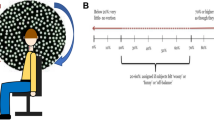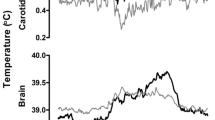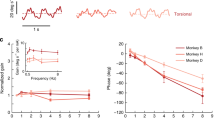Abstract
Core body temperature has been shown to affect vestibular end-organ and nerve afferents so that their resting discharge rate and sensitivity increase with temperature. Our aim was to determine whether these changes observed in extracellular nerve recordings of anaesthetized C57BL/6 mice corresponded to changes in the behavioural vestibulo-ocular reflex (VOR) of alert mice. The VOR drives eye rotations to keep images stable on the retina during head movements. We measured the VOR gain (eye velocity/head velocity) and phase (delay between vestibular stimulus and response) during whole-body sinusoidal rotations ranging 0.5–12 Hz with peak velocity 50 or 100 °/s in nine adult C57BL/6 mice. We also measured the VOR during whole-body transient rotations with acceleration 3000 or 6000 °/s2 reaching a plateau of 150 or 300 °/s. These measures were obtained while the mouse’s core body temperature was held at either 32 or 37 °C for at least 35 min before recording. The temperature presentation order and timing were pseudo-randomized. We found that a temperature increase from 32 to 37 °C caused a significant increase in sinusoidal VOR gain of 17 % (P < 0.001). Temperature had no other effects on the behavioural VOR. Our data suggest that temperature effects on regularly firing afferents best correspond to the changes that we observed in the VOR gain.


Similar content being viewed by others
References
Anniko M. Development of the vestibular system. JR. Coleman (Ed.), Development of sensory systems in mammals, Wiley, New York, 341–440, 1990
Baird RA, Desmadryl G, Fernandez C, Goldberg JM (1988) The vestibular nerve of the chinchilla. II Relation between afferent response properties and peripheral innervation patterns in the semicircular canals. J Neurophysiol 60:182–203
Beraneck M, Idoux E, Uno A (2004) Unilateral labyrinthectomy modifies the membrane properties of contralesional vestibular neurons. J Neurophysiol 92:1668–1684
Clendaniel RA, Lasker DM, Minor LB (2001) Horizontal vestibuloocular reflex evoked by high-acceleration rotations in the squirrel monkey. IV Responses after spectacle-induced adaptation. J Neurophysiol 86:1594–1611
Clendaniel RA, Lasker DM, Minor LB (2002) Differential adaptation of the linear and nonlinear components of the horizontal vestibuloocular reflex in squirrel monkeys. J Neurophysiol 88:3534–3540
Curthoys IS (1979) The development of function of horizontal semicircular canal primary neurons in the rat. Brain Res 167:41–52
Goldberg JM, Smith CE, Fernandez C (1984) Relation between discharge regularity and responses to externally applied galvanic currents in vestibular nerve afferents of the squirrel monkey. J Neurophysiol 51:1236–1256
Han GC, Lasker DM, Vetter DE, Minor LB. (2007) Extracellular recordings from semicircular canal afferents in mice that lack the alpha 9 nicotinic acetylcholine receptor subunit in ARO midwinter meeting, pp. 1–2
Hübner PP, Lim R, Brichta AM, Migliaccio AA (2013) Glycine receptor deficiency and its effect on the horizontal vestibulo-ocular reflex: a study on the SPD1J mouse. J Assoc Res Otolaryngol 14:249–259
Hübner PP, Khan SI, Migliaccio AA (2014) Velocity-selective adaptation of the horizontal and cross-axis vestibulo-ocular reflex in the mouse. Exp Brain Res 232:3035–3046
Hübner PP, Khan SI, Migliaccio AA (2015) The mammalian efferent vestibular system plays a crucial role in the high-frequency response and short-term adaptation of the vestibulo-ocular reflex. J Neurophysiol 114:3154–3165
Hübner PP, Khan SI, Migliaccio AA (2017) The mammalian efferent vestibular system plays a crucial role in vestibulo-ocular reflex compensation after unilateral labyrinthectomy. J Neurophysiol 117:1553–1568
Hullar TE, Minor LB (1999) High-frequency dynamics of regularly discharging canal afferents provide a linear signal for angular vestibulo-ocular reflexes. J Neurophysiol 82:2000–2005
Hullar TE, Della Santina CC, Hirvonen T, Lasker DM, Carey JP, Minor LB (2005) Responses of irregularly discharging chinchilla semicircular canal vestibular-nerve afferents during high-frequency head rotations. J Neurophysiol 93:2777–2786
Karlberg M, McGarvie L, Magnusson M, Aw ST, Halmagyi GM (2000) The effects of galvanic stimulation on the human vestibulo-ocular reflex. Neuroreport 11:3897–3901
Khan SI, Hübner PP, Brichta AM, Smith DW, Migliaccio AA (2017) Aging reduces the high-frequency and short-term adaptation of the vestibulo-ocular reflex in mice. Neurobiol Aging 51:122–131
Lasker DM, Backous DD, Lysakowski A, Davis GL, Minor LB (1999) Horizontal vestibuloocular reflex evoked by high-acceleration rotations in the squirrel monkey. II. Responses after canal plugging. J Neurophysiol 82:1271–1285
Lasker DM, Hullar TE, Minor LB (2000) Horizontal vestibuloocular reflex evoked by high-acceleration rotations in the squirrel monkey. III Responses after labyrinthectomy. J Neurophysiol 83:2482–2496
Lasker DM, Han GC, Park HJ, Minor LB (2008) Rotational responses of vestibular-nerve afferents innervating the semicircular canals in the C57BL/6 mouse. J Assoc Res Otolaryngol 9:334–348
Matta FV, Enticott JC (2004) The effects of state of alertness on the vestibulo-ocular reflex in normal subjects using the vestibular rotational chair. J Vestib Res 14:387–391
Migliaccio AA, Schubert MC, Jiradejvong P, Lasker DM, Clendaniel RA, Minor LB (2004a) The 3-dimensional vestibuloocular reflex evoked by high-acceleration rotations in the squirrel monkey. Exp Brain Res 159:433–446
Migliaccio AA, Minor LB, Carey JP (2004b) Vergence-mediated modulation of the human horizontal vestibulo-ocular reflex is eliminated by a partial peripheral gentamicin lesion. Exp Brain Res 159:92–98
Migliaccio AA, Minor LB, Carey JP (2008) Vergence-mediated modulation of the human angular vestibulo-ocular reflex is unaffected by canal plugging. Exp Brain Res 186:581–587
Migliaccio AA, Meierhofer R, Della Santina CC (2011) Characterization of the 3D angular vestibulo-ocular reflex in C57BL6 mice. Exp Brain Res 210:489–501
Migliaccio AA, Della Santina CC, Carey JP (2013) Transmastoid galvanic stimulation does not affect the vergence-mediated gain increase of the human angular vestibulo-ocular reflex. Exp Brain Res 224:489–499
Minor LB, Goldberg JM (1991) Vestibular-nerve inputs to the vestibulo-ocular reflex: a functional-ablation study in the squirrel monkey. J Neurosci 11:1636–1648
Minor LB, Goldberg JM (1990) Influence of static head position on the horizontal nystagmus evoked by caloric, rotational and optokinetic stimulation in the squirrel monkey. Exp Brain Res 82:1–13
Minor LB, Lasker DM, Backous DD, Hullar TE (1999) Horizontal vestibuloocular reflex evoked by high-acceleration rotations in the squirrel monkey. I Normal Responses J Neurophysiol 82:1254–1270
Nordemar H (1983) Postnatal development of the vestibular sensory epithelium in the mouse. Acta Otolaryngol 96:447–456
Park HJ, Lasker DM, Minor LB (2010) Static and dynamic discharge properties of vestibular-nerve afferents in the mouse are affected by core body temperature. Exp Brain Res 200:269–275
Rüsch A, Lysakowski A, Eatock RA (1998) Postnatal development of type I and type II hair cells in the mouse utricle: acquisition of voltage-gated conductances and differentiated morphology. J Neurosci 18:7487–7501
Sanchez-Alavez M, Alboni S, Conti B (2011) Sex- and age-specific differences in core body temperature of C57Bl/6 mice. Age (Dordr) 33:89–99
Suzuki M, Kadir A, Hayashi N, Takamoto M (1998) Direct influence of temperature on the semicircular canal receptor. J Vestib Res 8:169–173
Weissman BM, DiScenna AO, Ekelman BL, Leigh RJ (1989) Effect of eyelid closure and vocalization upon the vestibulo-ocular reflex during rotational testing. Ann Otol Rhinol Laryngol 98:548–550
Young JH, Anderson DJ (1974) Response patterns of primary vestibular neurons to thermal and rotational stimuli. Brain Res 79:199–212
Acknowledgements
A.A. Migliaccio was supported by The Garnett Passe and Rodney Williams Memorial Foundation Senior/Principal Research Fellowship in Otorhinolaryngology and NHMRC Project Grant APP1061752. P. P. Hübner was supported by a University of New South Wales (UNSW) International Research Scholarship and a Neuroscience Research Australia (NeuRA) supplementary scholarship.
Author information
Authors and Affiliations
Corresponding author
Ethics declarations
All surgical and experimental procedures were approved by the Animal Care and Ethics Committee of the University of New South Wales and were in strict compliance with the Australian Code of Practice for the Care and Use of Animals for Scientific Purposes.
Rights and permissions
About this article
Cite this article
Hübner, P.P., Khan, S.I., Lasker, D.M. et al. Core Body Temperature Effects on the Mouse Vestibulo-ocular Reflex. JARO 18, 827–835 (2017). https://doi.org/10.1007/s10162-017-0639-3
Received:
Accepted:
Published:
Issue Date:
DOI: https://doi.org/10.1007/s10162-017-0639-3




